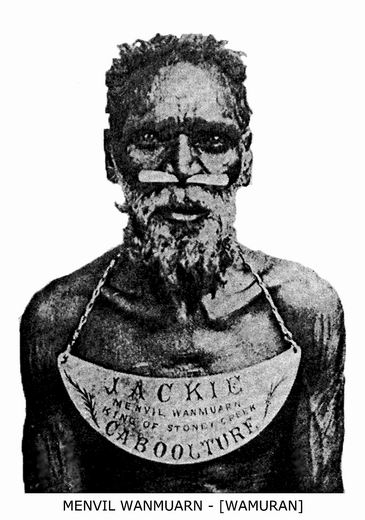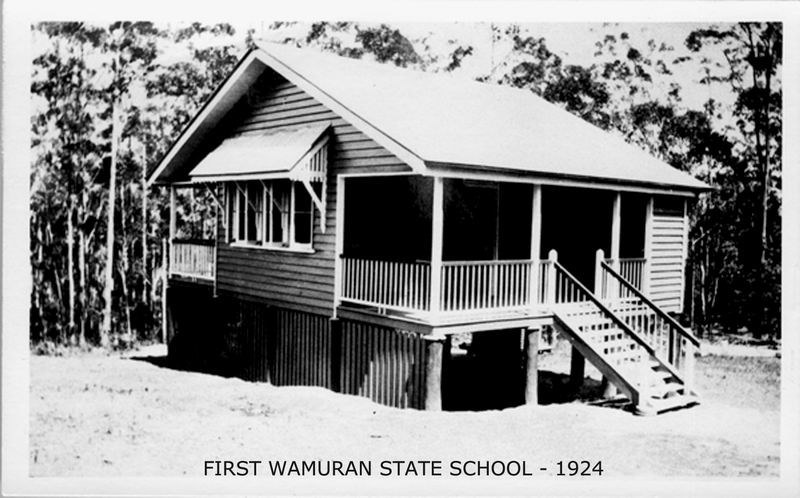Aboriginal People in Wamuran
Pre-Colonial / Aboriginal
The Caboolture area (including Wamuran) is the traditional home of the Kabi Kabi ( also called Gubbi Gubbi) Aboriginal people. The name ‘Kabultur’ is derived from the Yugarabul dialect meaning “place of the carpet snake”. The Kabi people harvested bush food, fresh water mussels, oysters, fish and some game animals, moving around the land to take best advantage of seasonally-available produce.
Each year in March, the Kabi people would hold Bunya Festivals to feast on the plentiful and nutritious annual nuts of the Bunya Pine. These huge trees provided a food source which could sustain large numbers of people. Neighbouring clans were invited to the festivals, where singing, dancing, story-telling, trading, and arranging of marriages took place.
(The above information is from Wikipedia, the free encyclopedia)
Wamuran Bora Ring
(Taken from “Spear & Musket 1879-1979 Caboolture Centenary” page 40)
“Mr & Mrs Flux of Basin Rd, Wamuran have a Bora Ring on their property. The area is now overgrown & the once evident pathway can no longer be seen. The second ring has never been found.
An early reference to this ring from the Queenslander of an unknown date, tells that this ring is in an excellent state of preservation with the embankment intact. The path from an opening in the large ring leads to the remains of a smaller ring some four or five hundred yards distant. The location is given as being in thickly wooded country and although only about two miles from the Wamuran station or siding, is not easily found without a guide. The article also states that ‘a number of trees have grown up within the ring since it was last used more than 25 years ago.”
“A Bora or Kippa Ring (from page 38 ‘Spear & Musket’) consists of a large circular earthwork, made by scraping out the centre of an area and piling the material in a circumference ring two or three feet high, and a diameter about sixty feet in southern Queensland. A long winding path also generally scraped out to make a trackway about three feet wide, leads to a second and smaller ring, hidden away out of sound of the large ceremony. It is in this smaller ring that the final ceremonies take place and so secret were these that no record has been made of them, nor does it seem that any white man ever saw this part of the ceremony.
All the tribe and visitors to the ceremony gathered at the large ring, and it was from here the young initiates were taken from their mothers after a certain amount of ‘play-acting’ and a more or less serious attempt by the mothers and other close female relatives to keep the boys in their care.
In starting on their first steps towards becoming men, the initiates were led down the trackway (often referred to as the ‘Sacred Way’) by some of the elders who stopped at various places on the way, to indoctrinate them into the myteries and background of the ceremony. At various places along the trackway, images, carved trees or ceremonial objects were placed; and it was at these the stories were told.
Finally they reached the small ring and were there confronted by an elder on a ‘throne’, made out of an up-ended wattle tree set upright in the ground with a matted root system forming the seat of the ‘throne’. We know little more than this of the happenings that took place in this part of the Bora Ring. Eventually, the initiate emerges as a “kippa”, the first stage of a long process towards full tribal manhood having been successfully passed. Their way of life is now different – they now join the men in doing the serious things in life, and their days of play were over.”
Canoe Trees
(from page 41 ‘Spear & Musket’)
“At least one tree with bark removed by aboriginals could be what is termed a ‘Canoe Tree’, ie. where a sheet of bark has been removed to make a canoe.”
One such tree was found in recent years up near Wararba Creek, Bracalba when Main Roads was doing maintenance and reconstruction of the D’Aguilar Highway and the bridge in that area. The tree was left untouched.
Local Place Names of Aboriginal Origin or Association
(from page 44/45 of ‘Spear & Musket)
Name Meaning
Bracalba – A scrub on the D’Aguilar Range
Caboolture – Place of carpet snakes
Elimbah – Place of the Grey Snake
Moodlu – From Mudlow – stone. The name given to a rocky hill in the neighbourhood; also Black Snakes.
Miketeebumulgrai Mt. – The place where the lightning struck (locally known as Mt. Miketee)
The Glasshouse Mountains are sacred to the Gubbi Gubbi people. A large number of volcanic rocks found here were used to make tools.
Wamuran – Part of the personal name of a local Aboriginal ‘King’, also known as Jackie Delaney.
Menvil Wanmaurn( the original name has a few spelling- this is from “Spear and Musket” page 14)- also known as Jackie Delaney (Delaney was his employer). Jackie and his wife Kitty roamed many kilometres to get plentiful seasonal food. They moved from Upper Caboolture to Burpengary Creek, Mount Mee (Wakka Wakka country), Deception Bay, Wamuran, Redcliffe and Stradbroke Island- all over the Moreton Bay Region. There is a tale that Menvil worked on a banana plantation in the ranges near Wamuran and the owner named his plantation “Wamuran” after this fine indigenous man. When the railway arrived in 1909 in Wamuran (previously known as Wararba) the town was then given the name of Wamuran.
Photo of Menvil Wanmaurn- note the nasal septum and the cicatrisation scars. The breast plate was made by Europeans and he was Jackie after his boss Joe Delaney where he was a stockman on his property at Narangba. His breast plate also says he is the king of Stony Creek which is what Upper Caboolture and Burpengary Creek used to be called and where stayed regularly. He died in summer 1900 and in 1959 his grave was marked with a plaque on a tree in a pine plantation east of Oakey Flat Road and just south of Burpengary Creek. Menvil Wanmuarn (later called Jackie Delaney) came from the Quandamook people of Stradbroke Island and went to Mt Mee in the D’Aguilar Range (Wakka Wakka country) where he probably met his wife Kitty who was from the Dallambara people. Kitty was the daughter of King Sambo and Queen Beauty who had often been seen in the Rocksberg area collecting bunya nuts as noted by the MacNamara family who lived there. In their younger days Jackie, Kitty and family moved in the area between Mt Mee, head of the Caboolture River, Wamuran, Upper Burpengary Creek (Stony Creek) , Deception Bay and Redcliffe Peninsula. Menvil became a stockman for Joe Delaney who had a Stony Creek cattle spread that extended from Upper Caboolture, to Burpengary Creek, Narangba and Redcliffe Peninsula; all in Moreton Bay region
Wararba – Box Tree, or the district dialect name for the Kippa Ring or Bora ceremony.

